Business Law Analysis: Contractual Obligations and Negligence Cases
VerifiedAdded on 2020/11/23
|8
|2138
|101
Report
AI Summary
This business law report examines two key legal issues: a contractual dispute between Chiclets plc and Delta Delivery Ltd, and a negligence claim by an injured employee named Joe. The first part analyzes the enforceability of an exclusion clause in the contract between Chiclets plc and Delta Delivery, focusing on issues of consideration, the Supply of Goods and Service Act 1982, common law principles (incorporation and construction rules), and the Unfair Contract Terms Act 1977. The analysis considers misrepresentation and the burden of proof for the defendant (Delta Delivery). The second part assesses Joe's claim for his injury, exploring the tort of negligence, including duty of care, breach of duty, causation, and damages. The report also considers defenses such as vicarious liability. The analysis relies on case law such as Donoghue v Stevenson, and Grant v Australian Knitting Mills, and concludes with a discussion of potential outcomes for each case.
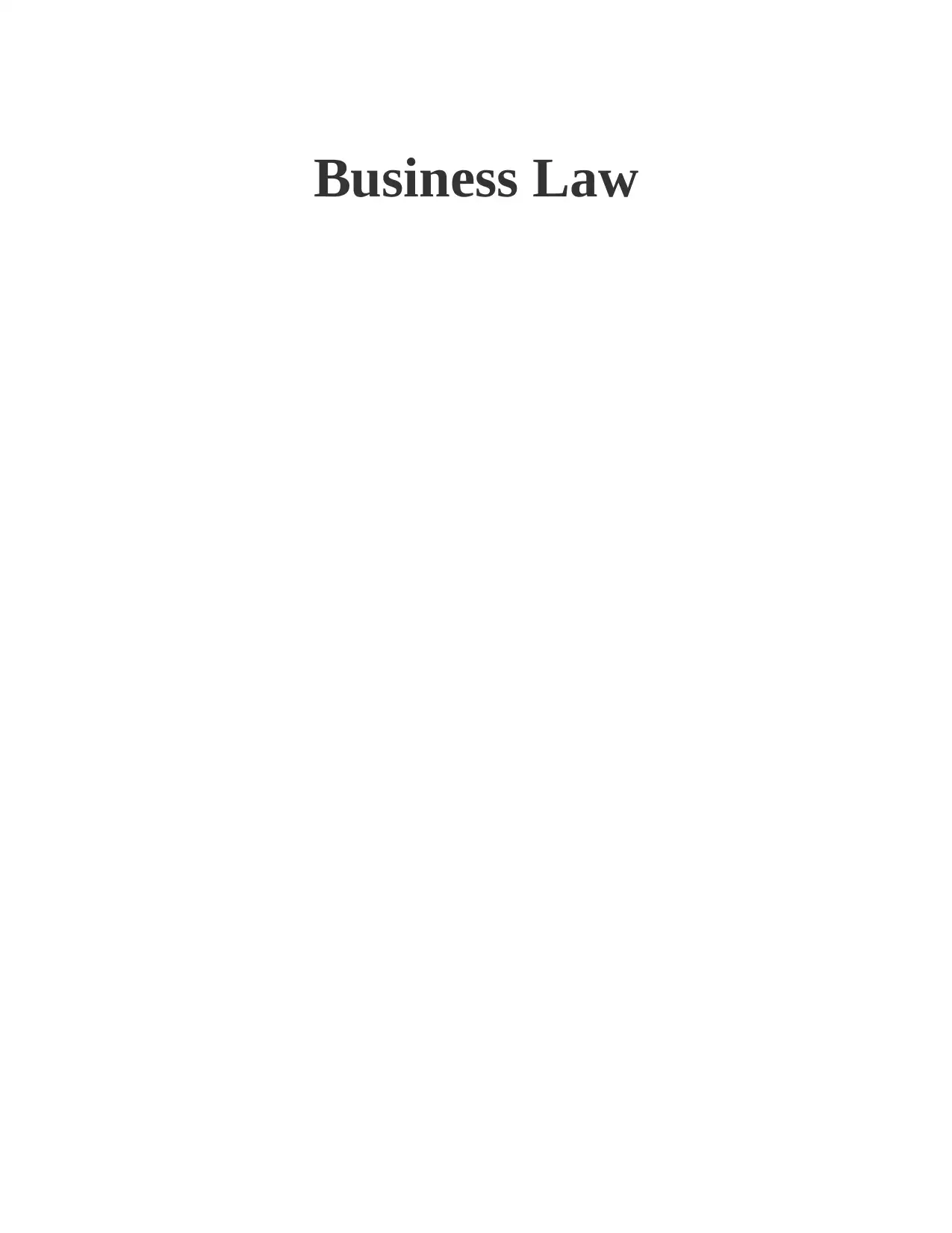
Business Law
Paraphrase This Document
Need a fresh take? Get an instant paraphrase of this document with our AI Paraphraser
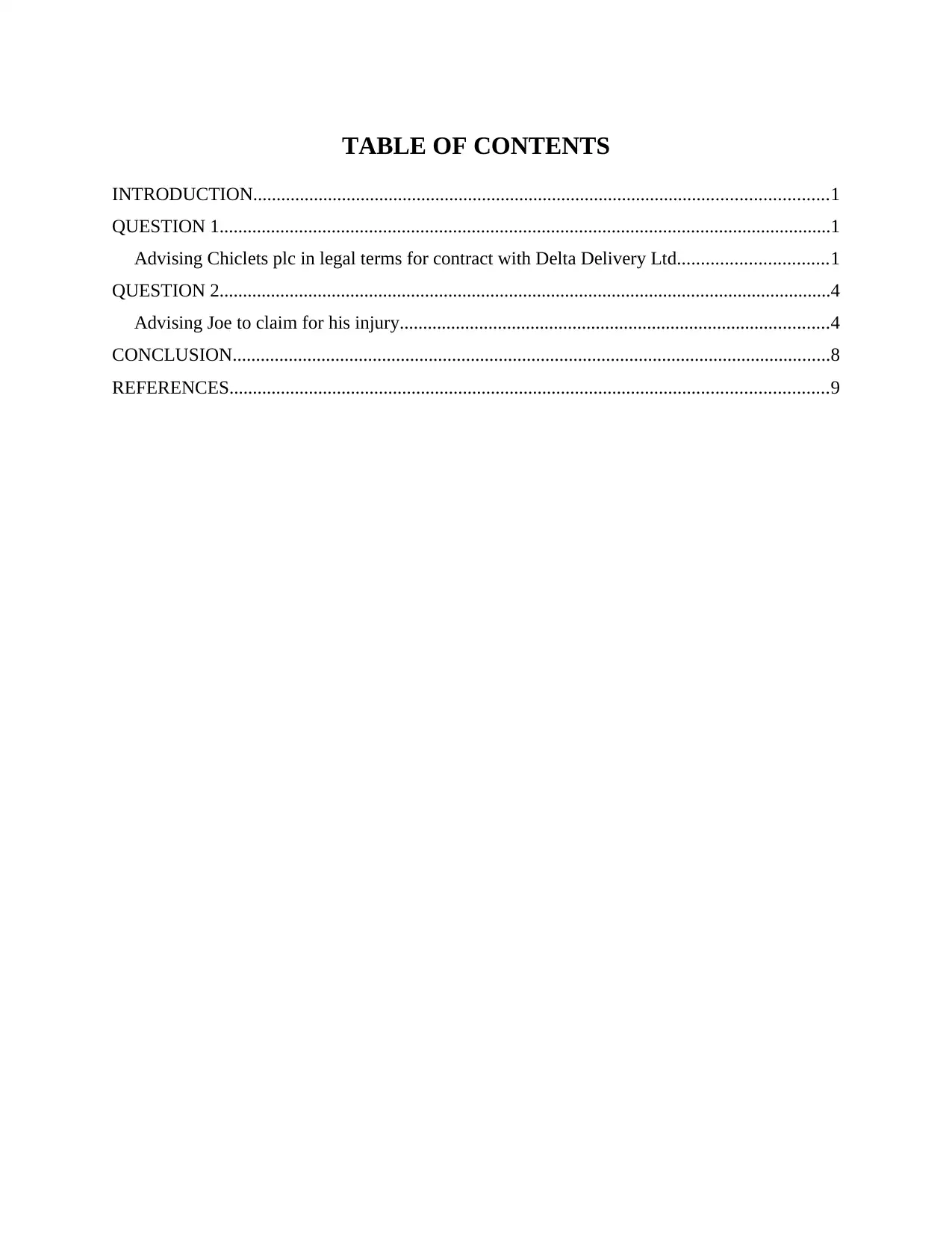
TABLE OF CONTENTS
INTRODUCTION...........................................................................................................................1
QUESTION 1...................................................................................................................................1
Advising Chiclets plc in legal terms for contract with Delta Delivery Ltd................................1
QUESTION 2...................................................................................................................................4
Advising Joe to claim for his injury............................................................................................4
CONCLUSION................................................................................................................................8
REFERENCES................................................................................................................................9
INTRODUCTION...........................................................................................................................1
QUESTION 1...................................................................................................................................1
Advising Chiclets plc in legal terms for contract with Delta Delivery Ltd................................1
QUESTION 2...................................................................................................................................4
Advising Joe to claim for his injury............................................................................................4
CONCLUSION................................................................................................................................8
REFERENCES................................................................................................................................9
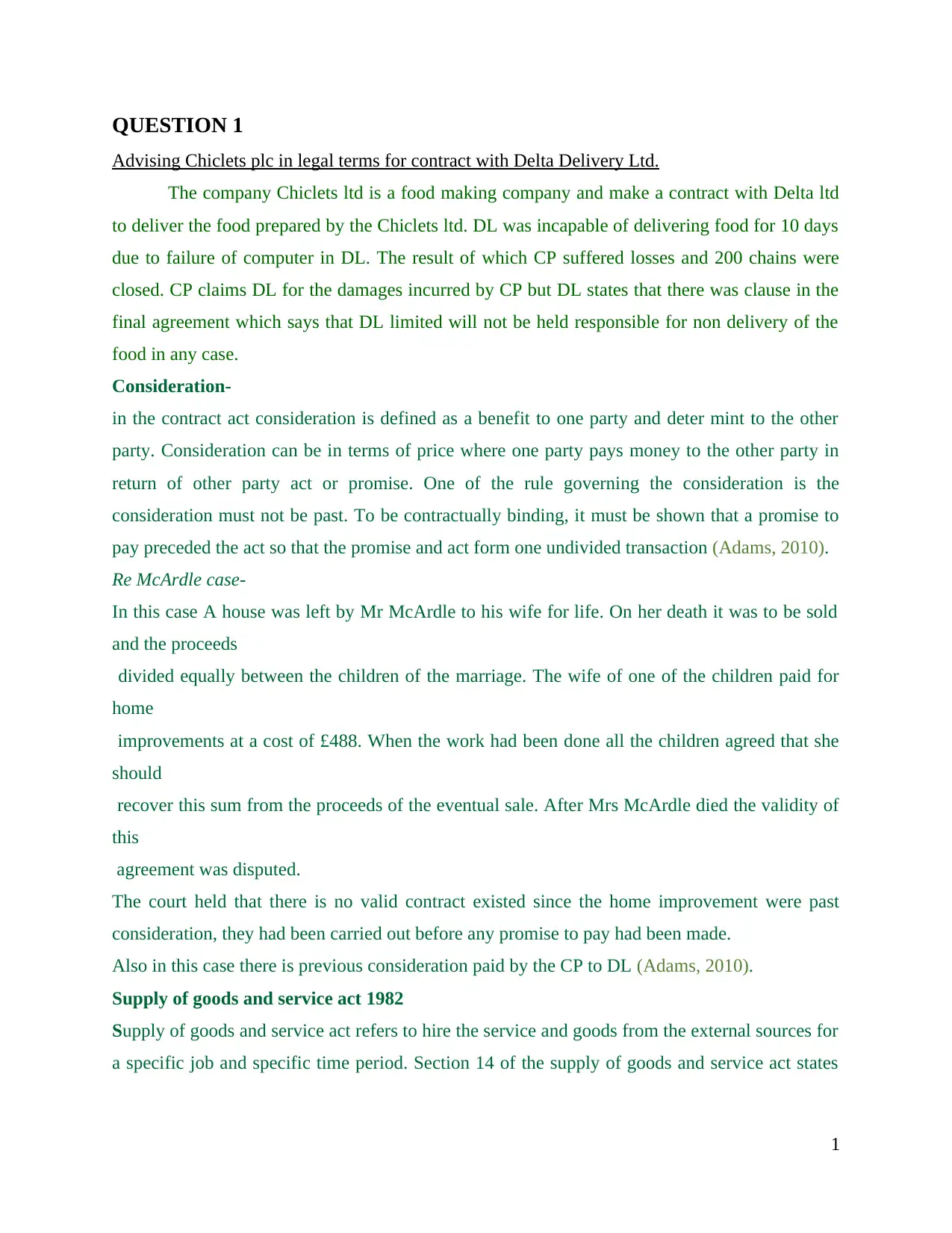
QUESTION 1
Advising Chiclets plc in legal terms for contract with Delta Delivery Ltd.
The company Chiclets ltd is a food making company and make a contract with Delta ltd
to deliver the food prepared by the Chiclets ltd. DL was incapable of delivering food for 10 days
due to failure of computer in DL. The result of which CP suffered losses and 200 chains were
closed. CP claims DL for the damages incurred by CP but DL states that there was clause in the
final agreement which says that DL limited will not be held responsible for non delivery of the
food in any case.
Consideration-
in the contract act consideration is defined as a benefit to one party and deter mint to the other
party. Consideration can be in terms of price where one party pays money to the other party in
return of other party act or promise. One of the rule governing the consideration is the
consideration must not be past. To be contractually binding, it must be shown that a promise to
pay preceded the act so that the promise and act form one undivided transaction (Adams, 2010).
Re McArdle case-
In this case A house was left by Mr McArdle to his wife for life. On her death it was to be sold
and the proceeds
divided equally between the children of the marriage. The wife of one of the children paid for
home
improvements at a cost of £488. When the work had been done all the children agreed that she
should
recover this sum from the proceeds of the eventual sale. After Mrs McArdle died the validity of
this
agreement was disputed.
The court held that there is no valid contract existed since the home improvement were past
consideration, they had been carried out before any promise to pay had been made.
Also in this case there is previous consideration paid by the CP to DL (Adams, 2010).
Supply of goods and service act 1982
Supply of goods and service act refers to hire the service and goods from the external sources for
a specific job and specific time period. Section 14 of the supply of goods and service act states
1
Advising Chiclets plc in legal terms for contract with Delta Delivery Ltd.
The company Chiclets ltd is a food making company and make a contract with Delta ltd
to deliver the food prepared by the Chiclets ltd. DL was incapable of delivering food for 10 days
due to failure of computer in DL. The result of which CP suffered losses and 200 chains were
closed. CP claims DL for the damages incurred by CP but DL states that there was clause in the
final agreement which says that DL limited will not be held responsible for non delivery of the
food in any case.
Consideration-
in the contract act consideration is defined as a benefit to one party and deter mint to the other
party. Consideration can be in terms of price where one party pays money to the other party in
return of other party act or promise. One of the rule governing the consideration is the
consideration must not be past. To be contractually binding, it must be shown that a promise to
pay preceded the act so that the promise and act form one undivided transaction (Adams, 2010).
Re McArdle case-
In this case A house was left by Mr McArdle to his wife for life. On her death it was to be sold
and the proceeds
divided equally between the children of the marriage. The wife of one of the children paid for
home
improvements at a cost of £488. When the work had been done all the children agreed that she
should
recover this sum from the proceeds of the eventual sale. After Mrs McArdle died the validity of
this
agreement was disputed.
The court held that there is no valid contract existed since the home improvement were past
consideration, they had been carried out before any promise to pay had been made.
Also in this case there is previous consideration paid by the CP to DL (Adams, 2010).
Supply of goods and service act 1982
Supply of goods and service act refers to hire the service and goods from the external sources for
a specific job and specific time period. Section 14 of the supply of goods and service act states
1
⊘ This is a preview!⊘
Do you want full access?
Subscribe today to unlock all pages.

Trusted by 1+ million students worldwide
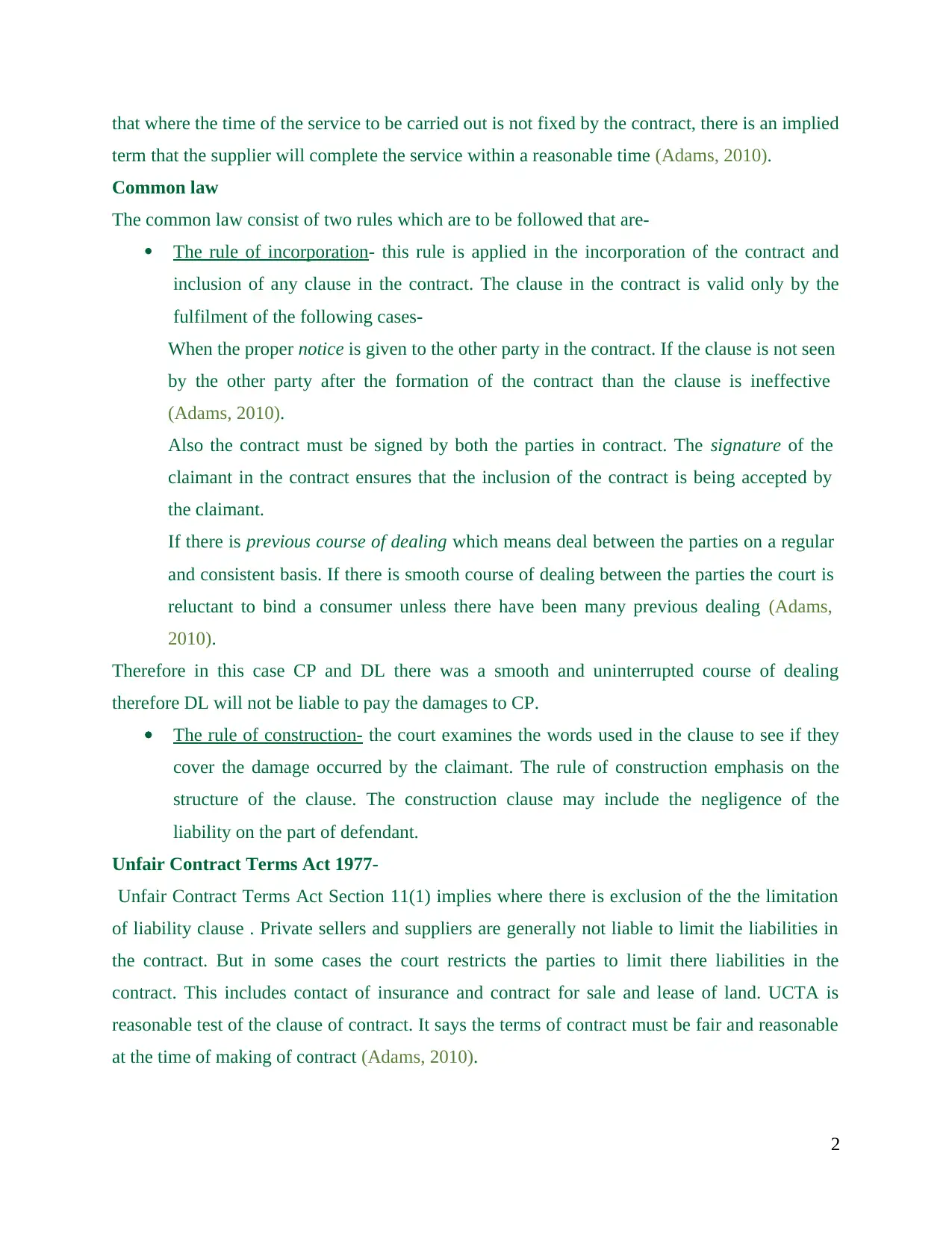
that where the time of the service to be carried out is not fixed by the contract, there is an implied
term that the supplier will complete the service within a reasonable time (Adams, 2010).
Common law
The common law consist of two rules which are to be followed that are-
The rule of incorporation- this rule is applied in the incorporation of the contract and
inclusion of any clause in the contract. The clause in the contract is valid only by the
fulfilment of the following cases-
When the proper notice is given to the other party in the contract. If the clause is not seen
by the other party after the formation of the contract than the clause is ineffective
(Adams, 2010).
Also the contract must be signed by both the parties in contract. The signature of the
claimant in the contract ensures that the inclusion of the contract is being accepted by
the claimant.
If there is previous course of dealing which means deal between the parties on a regular
and consistent basis. If there is smooth course of dealing between the parties the court is
reluctant to bind a consumer unless there have been many previous dealing (Adams,
2010).
Therefore in this case CP and DL there was a smooth and uninterrupted course of dealing
therefore DL will not be liable to pay the damages to CP.
The rule of construction- the court examines the words used in the clause to see if they
cover the damage occurred by the claimant. The rule of construction emphasis on the
structure of the clause. The construction clause may include the negligence of the
liability on the part of defendant.
Unfair Contract Terms Act 1977-
Unfair Contract Terms Act Section 11(1) implies where there is exclusion of the the limitation
of liability clause . Private sellers and suppliers are generally not liable to limit the liabilities in
the contract. But in some cases the court restricts the parties to limit there liabilities in the
contract. This includes contact of insurance and contract for sale and lease of land. UCTA is
reasonable test of the clause of contract. It says the terms of contract must be fair and reasonable
at the time of making of contract (Adams, 2010).
2
term that the supplier will complete the service within a reasonable time (Adams, 2010).
Common law
The common law consist of two rules which are to be followed that are-
The rule of incorporation- this rule is applied in the incorporation of the contract and
inclusion of any clause in the contract. The clause in the contract is valid only by the
fulfilment of the following cases-
When the proper notice is given to the other party in the contract. If the clause is not seen
by the other party after the formation of the contract than the clause is ineffective
(Adams, 2010).
Also the contract must be signed by both the parties in contract. The signature of the
claimant in the contract ensures that the inclusion of the contract is being accepted by
the claimant.
If there is previous course of dealing which means deal between the parties on a regular
and consistent basis. If there is smooth course of dealing between the parties the court is
reluctant to bind a consumer unless there have been many previous dealing (Adams,
2010).
Therefore in this case CP and DL there was a smooth and uninterrupted course of dealing
therefore DL will not be liable to pay the damages to CP.
The rule of construction- the court examines the words used in the clause to see if they
cover the damage occurred by the claimant. The rule of construction emphasis on the
structure of the clause. The construction clause may include the negligence of the
liability on the part of defendant.
Unfair Contract Terms Act 1977-
Unfair Contract Terms Act Section 11(1) implies where there is exclusion of the the limitation
of liability clause . Private sellers and suppliers are generally not liable to limit the liabilities in
the contract. But in some cases the court restricts the parties to limit there liabilities in the
contract. This includes contact of insurance and contract for sale and lease of land. UCTA is
reasonable test of the clause of contract. It says the terms of contract must be fair and reasonable
at the time of making of contract (Adams, 2010).
2
Paraphrase This Document
Need a fresh take? Get an instant paraphrase of this document with our AI Paraphraser
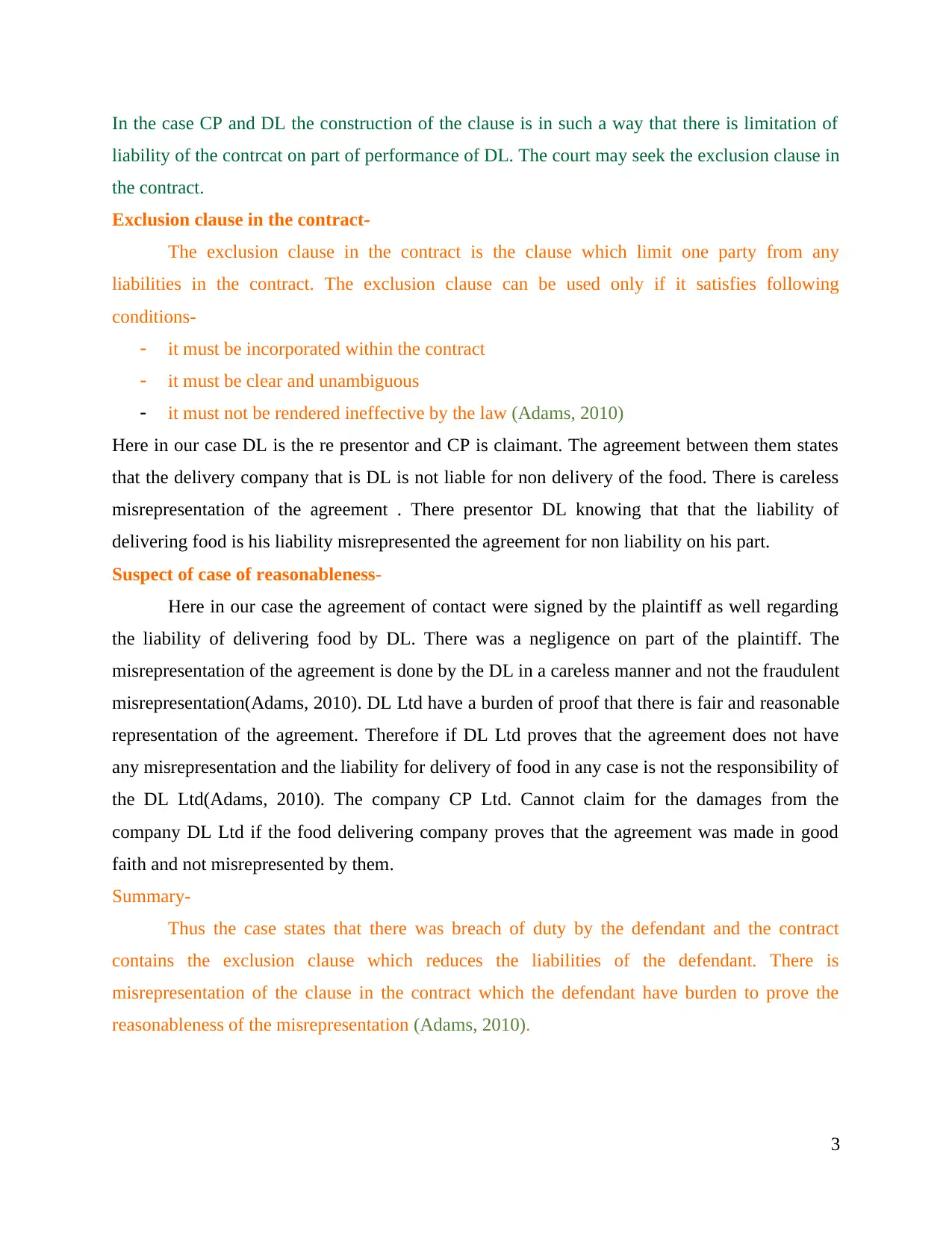
In the case CP and DL the construction of the clause is in such a way that there is limitation of
liability of the contrcat on part of performance of DL. The court may seek the exclusion clause in
the contract.
Exclusion clause in the contract-
The exclusion clause in the contract is the clause which limit one party from any
liabilities in the contract. The exclusion clause can be used only if it satisfies following
conditions-
it must be incorporated within the contract
it must be clear and unambiguous
it must not be rendered ineffective by the law (Adams, 2010)
Here in our case DL is the re presentor and CP is claimant. The agreement between them states
that the delivery company that is DL is not liable for non delivery of the food. There is careless
misrepresentation of the agreement . There presentor DL knowing that that the liability of
delivering food is his liability misrepresented the agreement for non liability on his part.
Suspect of case of reasonableness-
Here in our case the agreement of contact were signed by the plaintiff as well regarding
the liability of delivering food by DL. There was a negligence on part of the plaintiff. The
misrepresentation of the agreement is done by the DL in a careless manner and not the fraudulent
misrepresentation(Adams, 2010). DL Ltd have a burden of proof that there is fair and reasonable
representation of the agreement. Therefore if DL Ltd proves that the agreement does not have
any misrepresentation and the liability for delivery of food in any case is not the responsibility of
the DL Ltd(Adams, 2010). The company CP Ltd. Cannot claim for the damages from the
company DL Ltd if the food delivering company proves that the agreement was made in good
faith and not misrepresented by them.
Summary-
Thus the case states that there was breach of duty by the defendant and the contract
contains the exclusion clause which reduces the liabilities of the defendant. There is
misrepresentation of the clause in the contract which the defendant have burden to prove the
reasonableness of the misrepresentation (Adams, 2010).
3
liability of the contrcat on part of performance of DL. The court may seek the exclusion clause in
the contract.
Exclusion clause in the contract-
The exclusion clause in the contract is the clause which limit one party from any
liabilities in the contract. The exclusion clause can be used only if it satisfies following
conditions-
it must be incorporated within the contract
it must be clear and unambiguous
it must not be rendered ineffective by the law (Adams, 2010)
Here in our case DL is the re presentor and CP is claimant. The agreement between them states
that the delivery company that is DL is not liable for non delivery of the food. There is careless
misrepresentation of the agreement . There presentor DL knowing that that the liability of
delivering food is his liability misrepresented the agreement for non liability on his part.
Suspect of case of reasonableness-
Here in our case the agreement of contact were signed by the plaintiff as well regarding
the liability of delivering food by DL. There was a negligence on part of the plaintiff. The
misrepresentation of the agreement is done by the DL in a careless manner and not the fraudulent
misrepresentation(Adams, 2010). DL Ltd have a burden of proof that there is fair and reasonable
representation of the agreement. Therefore if DL Ltd proves that the agreement does not have
any misrepresentation and the liability for delivery of food in any case is not the responsibility of
the DL Ltd(Adams, 2010). The company CP Ltd. Cannot claim for the damages from the
company DL Ltd if the food delivering company proves that the agreement was made in good
faith and not misrepresented by them.
Summary-
Thus the case states that there was breach of duty by the defendant and the contract
contains the exclusion clause which reduces the liabilities of the defendant. There is
misrepresentation of the clause in the contract which the defendant have burden to prove the
reasonableness of the misrepresentation (Adams, 2010).
3
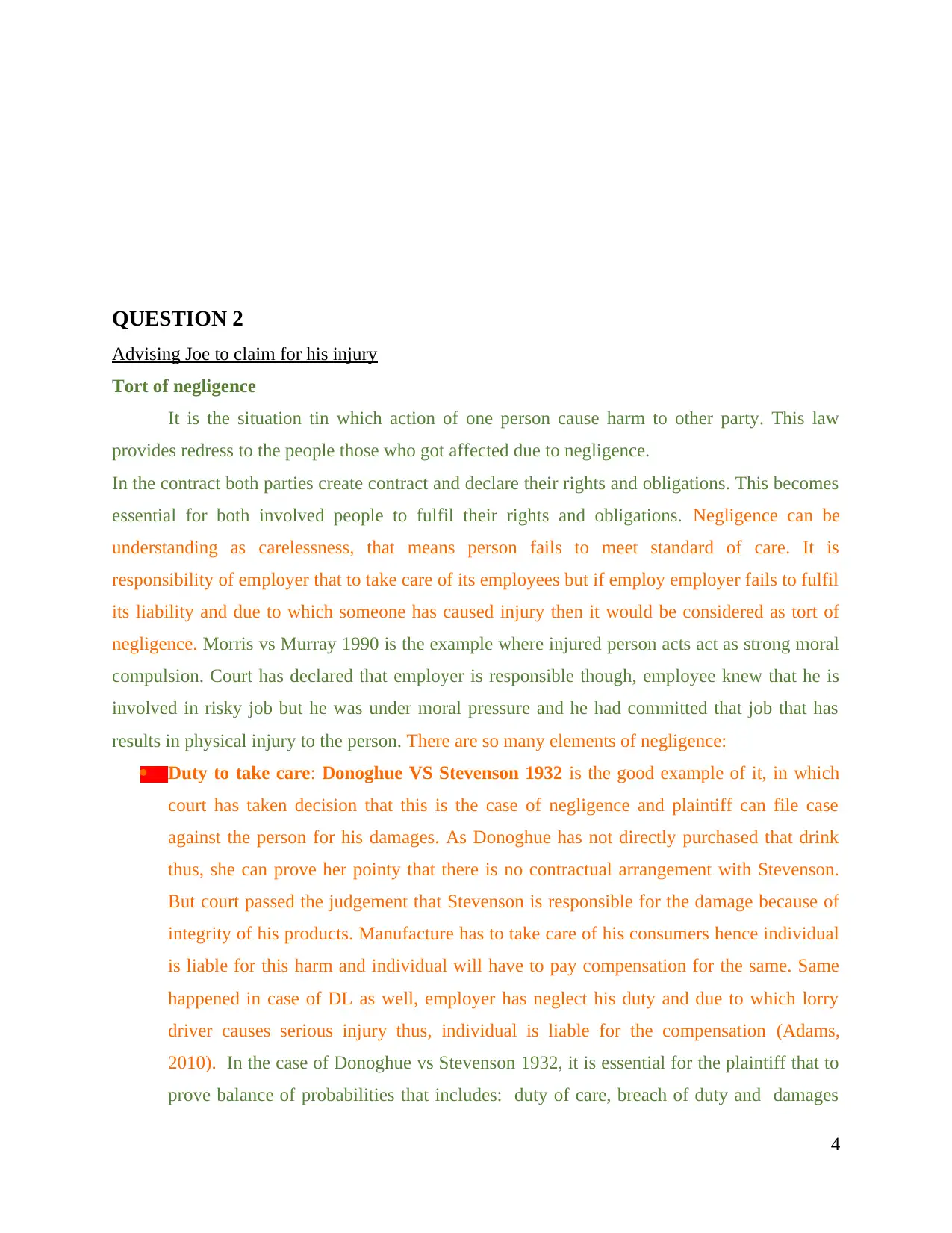
QUESTION 2
Advising Joe to claim for his injury
Tort of negligence
It is the situation tin which action of one person cause harm to other party. This law
provides redress to the people those who got affected due to negligence.
In the contract both parties create contract and declare their rights and obligations. This becomes
essential for both involved people to fulfil their rights and obligations. Negligence can be
understanding as carelessness, that means person fails to meet standard of care. It is
responsibility of employer that to take care of its employees but if employ employer fails to fulfil
its liability and due to which someone has caused injury then it would be considered as tort of
negligence. Morris vs Murray 1990 is the example where injured person acts act as strong moral
compulsion. Court has declared that employer is responsible though, employee knew that he is
involved in risky job but he was under moral pressure and he had committed that job that has
results in physical injury to the person. There are so many elements of negligence:
Duty to take care: Donoghue VS Stevenson 1932 is the good example of it, in which
court has taken decision that this is the case of negligence and plaintiff can file case
against the person for his damages. As Donoghue has not directly purchased that drink
thus, she can prove her pointy that there is no contractual arrangement with Stevenson.
But court passed the judgement that Stevenson is responsible for the damage because of
integrity of his products. Manufacture has to take care of his consumers hence individual
is liable for this harm and individual will have to pay compensation for the same. Same
happened in case of DL as well, employer has neglect his duty and due to which lorry
driver causes serious injury thus, individual is liable for the compensation (Adams,
2010). In the case of Donoghue vs Stevenson 1932, it is essential for the plaintiff that to
prove balance of probabilities that includes: duty of care, breach of duty and damages
4
Advising Joe to claim for his injury
Tort of negligence
It is the situation tin which action of one person cause harm to other party. This law
provides redress to the people those who got affected due to negligence.
In the contract both parties create contract and declare their rights and obligations. This becomes
essential for both involved people to fulfil their rights and obligations. Negligence can be
understanding as carelessness, that means person fails to meet standard of care. It is
responsibility of employer that to take care of its employees but if employ employer fails to fulfil
its liability and due to which someone has caused injury then it would be considered as tort of
negligence. Morris vs Murray 1990 is the example where injured person acts act as strong moral
compulsion. Court has declared that employer is responsible though, employee knew that he is
involved in risky job but he was under moral pressure and he had committed that job that has
results in physical injury to the person. There are so many elements of negligence:
Duty to take care: Donoghue VS Stevenson 1932 is the good example of it, in which
court has taken decision that this is the case of negligence and plaintiff can file case
against the person for his damages. As Donoghue has not directly purchased that drink
thus, she can prove her pointy that there is no contractual arrangement with Stevenson.
But court passed the judgement that Stevenson is responsible for the damage because of
integrity of his products. Manufacture has to take care of his consumers hence individual
is liable for this harm and individual will have to pay compensation for the same. Same
happened in case of DL as well, employer has neglect his duty and due to which lorry
driver causes serious injury thus, individual is liable for the compensation (Adams,
2010). In the case of Donoghue vs Stevenson 1932, it is essential for the plaintiff that to
prove balance of probabilities that includes: duty of care, breach of duty and damages
4
⊘ This is a preview!⊘
Do you want full access?
Subscribe today to unlock all pages.

Trusted by 1+ million students worldwide
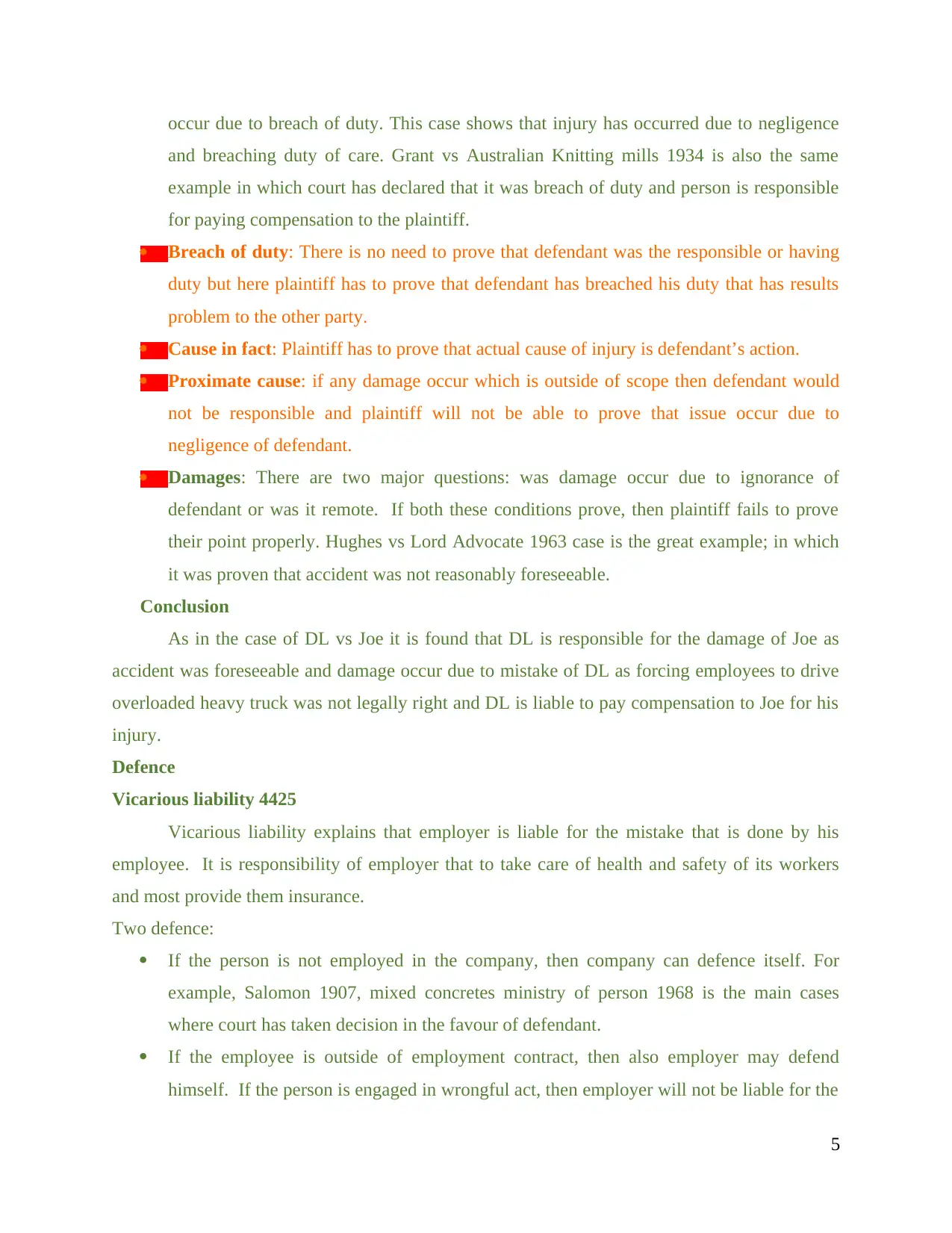
occur due to breach of duty. This case shows that injury has occurred due to negligence
and breaching duty of care. Grant vs Australian Knitting mills 1934 is also the same
example in which court has declared that it was breach of duty and person is responsible
for paying compensation to the plaintiff.
Breach of duty: There is no need to prove that defendant was the responsible or having
duty but here plaintiff has to prove that defendant has breached his duty that has results
problem to the other party.
Cause in fact: Plaintiff has to prove that actual cause of injury is defendant’s action.
Proximate cause: if any damage occur which is outside of scope then defendant would
not be responsible and plaintiff will not be able to prove that issue occur due to
negligence of defendant.
Damages: There are two major questions: was damage occur due to ignorance of
defendant or was it remote. If both these conditions prove, then plaintiff fails to prove
their point properly. Hughes vs Lord Advocate 1963 case is the great example; in which
it was proven that accident was not reasonably foreseeable.
Conclusion
As in the case of DL vs Joe it is found that DL is responsible for the damage of Joe as
accident was foreseeable and damage occur due to mistake of DL as forcing employees to drive
overloaded heavy truck was not legally right and DL is liable to pay compensation to Joe for his
injury.
Defence
Vicarious liability 4425
Vicarious liability explains that employer is liable for the mistake that is done by his
employee. It is responsibility of employer that to take care of health and safety of its workers
and most provide them insurance.
Two defence:
If the person is not employed in the company, then company can defence itself. For
example, Salomon 1907, mixed concretes ministry of person 1968 is the main cases
where court has taken decision in the favour of defendant.
If the employee is outside of employment contract, then also employer may defend
himself. If the person is engaged in wrongful act, then employer will not be liable for the
5
and breaching duty of care. Grant vs Australian Knitting mills 1934 is also the same
example in which court has declared that it was breach of duty and person is responsible
for paying compensation to the plaintiff.
Breach of duty: There is no need to prove that defendant was the responsible or having
duty but here plaintiff has to prove that defendant has breached his duty that has results
problem to the other party.
Cause in fact: Plaintiff has to prove that actual cause of injury is defendant’s action.
Proximate cause: if any damage occur which is outside of scope then defendant would
not be responsible and plaintiff will not be able to prove that issue occur due to
negligence of defendant.
Damages: There are two major questions: was damage occur due to ignorance of
defendant or was it remote. If both these conditions prove, then plaintiff fails to prove
their point properly. Hughes vs Lord Advocate 1963 case is the great example; in which
it was proven that accident was not reasonably foreseeable.
Conclusion
As in the case of DL vs Joe it is found that DL is responsible for the damage of Joe as
accident was foreseeable and damage occur due to mistake of DL as forcing employees to drive
overloaded heavy truck was not legally right and DL is liable to pay compensation to Joe for his
injury.
Defence
Vicarious liability 4425
Vicarious liability explains that employer is liable for the mistake that is done by his
employee. It is responsibility of employer that to take care of health and safety of its workers
and most provide them insurance.
Two defence:
If the person is not employed in the company, then company can defence itself. For
example, Salomon 1907, mixed concretes ministry of person 1968 is the main cases
where court has taken decision in the favour of defendant.
If the employee is outside of employment contract, then also employer may defend
himself. If the person is engaged in wrongful act, then employer will not be liable for the
5
Paraphrase This Document
Need a fresh take? Get an instant paraphrase of this document with our AI Paraphraser
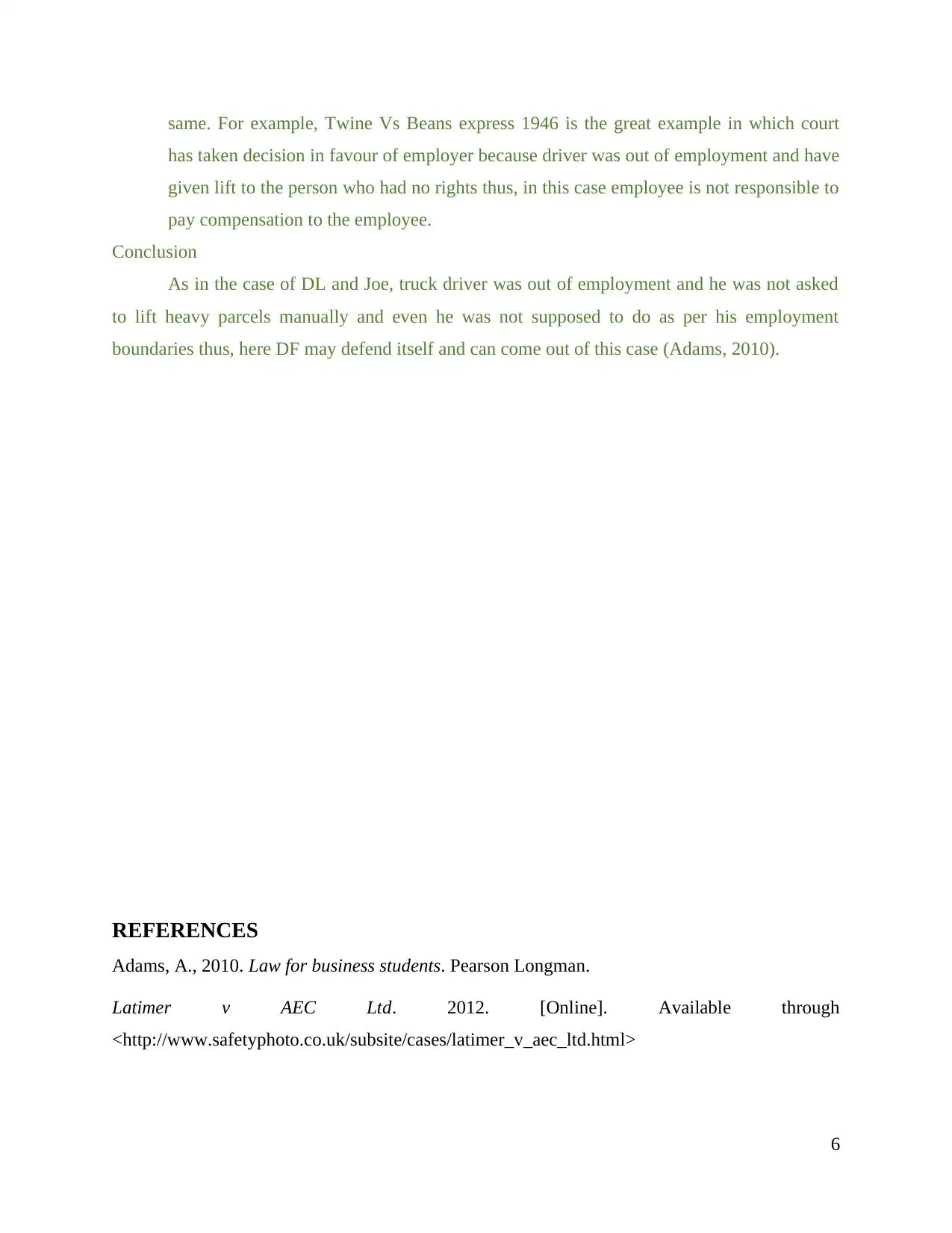
same. For example, Twine Vs Beans express 1946 is the great example in which court
has taken decision in favour of employer because driver was out of employment and have
given lift to the person who had no rights thus, in this case employee is not responsible to
pay compensation to the employee.
Conclusion
As in the case of DL and Joe, truck driver was out of employment and he was not asked
to lift heavy parcels manually and even he was not supposed to do as per his employment
boundaries thus, here DF may defend itself and can come out of this case (Adams, 2010).
REFERENCES
Adams, A., 2010. Law for business students. Pearson Longman.
Latimer v AEC Ltd. 2012. [Online]. Available through
<http://www.safetyphoto.co.uk/subsite/cases/latimer_v_aec_ltd.html>
6
has taken decision in favour of employer because driver was out of employment and have
given lift to the person who had no rights thus, in this case employee is not responsible to
pay compensation to the employee.
Conclusion
As in the case of DL and Joe, truck driver was out of employment and he was not asked
to lift heavy parcels manually and even he was not supposed to do as per his employment
boundaries thus, here DF may defend itself and can come out of this case (Adams, 2010).
REFERENCES
Adams, A., 2010. Law for business students. Pearson Longman.
Latimer v AEC Ltd. 2012. [Online]. Available through
<http://www.safetyphoto.co.uk/subsite/cases/latimer_v_aec_ltd.html>
6
1 out of 8
Related Documents
Your All-in-One AI-Powered Toolkit for Academic Success.
+13062052269
info@desklib.com
Available 24*7 on WhatsApp / Email
![[object Object]](/_next/static/media/star-bottom.7253800d.svg)
Unlock your academic potential
Copyright © 2020–2025 A2Z Services. All Rights Reserved. Developed and managed by ZUCOL.




